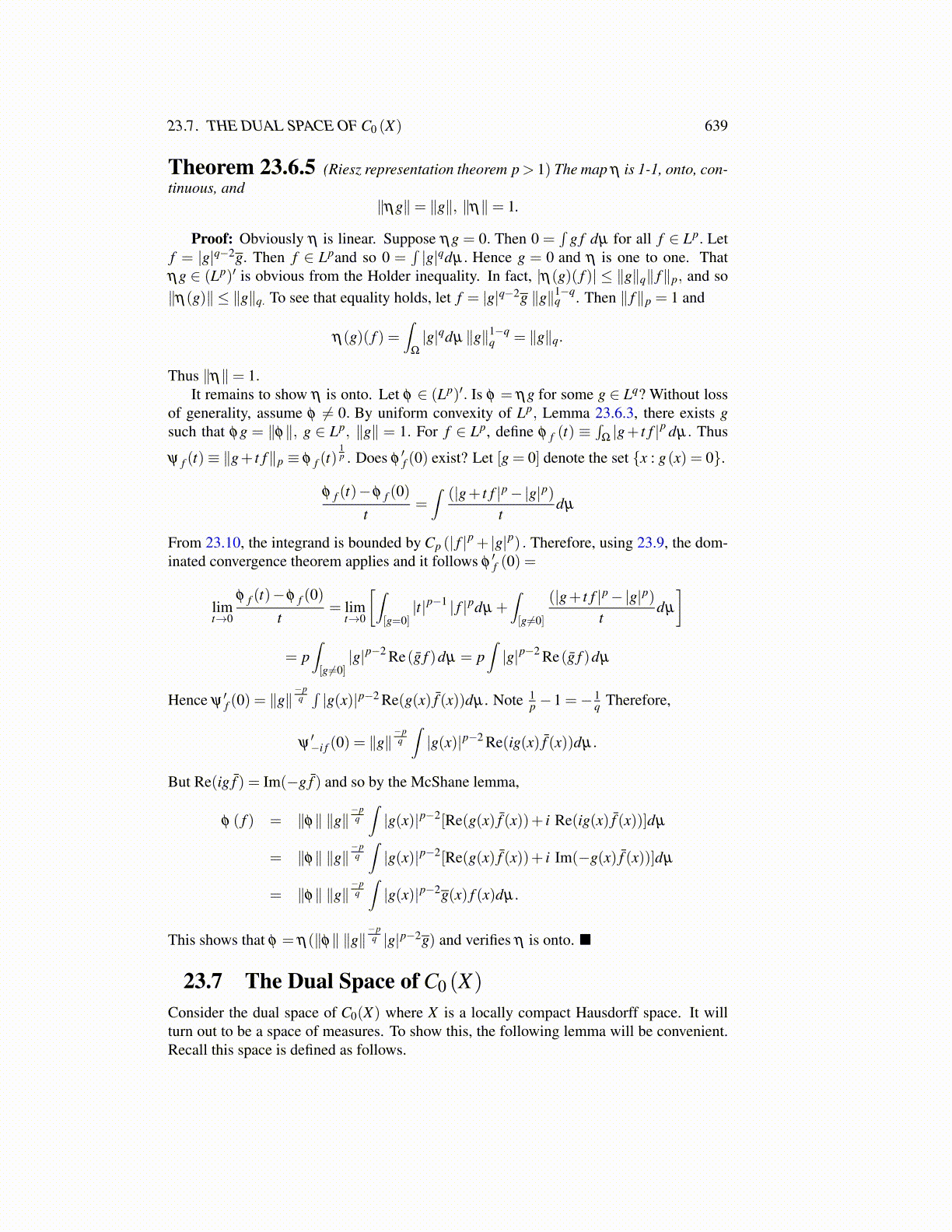
23.7. THE DUAL SPACE OF C0 (X) 639
Theorem 23.6.5 (Riesz representation theorem p> 1) The map η is 1-1, onto, con-tinuous, and
∥ηg∥= ∥g∥, ∥η∥= 1.
Proof: Obviously η is linear. Suppose ηg = 0. Then 0 =∫
g f dµ for all f ∈ Lp. Letf = |g|q−2g. Then f ∈ Lpand so 0 =
∫|g|qdµ. Hence g = 0 and η is one to one. That
ηg ∈ (Lp)′ is obvious from the Holder inequality. In fact, |η(g)( f )| ≤ ∥g∥q∥ f∥p, and so∥η(g)∥ ≤ ∥g∥q. To see that equality holds, let f = |g|q−2g ∥g∥1−q
q . Then ∥ f∥p = 1 and
η(g)( f ) =∫
Ω
|g|qdµ ∥g∥1−qq = ∥g∥q.
Thus ∥η∥= 1.It remains to show η is onto. Let φ ∈ (Lp)′. Is φ = ηg for some g ∈ Lq? Without loss
of generality, assume φ ̸= 0. By uniform convexity of Lp, Lemma 23.6.3, there exists gsuch that φg = ∥φ∥, g ∈ Lp, ∥g∥ = 1. For f ∈ Lp, define φ f (t) ≡
∫Ω|g+ t f |p dµ. Thus
ψ f (t)≡ ∥g+ t f∥p ≡ φ f (t)1p . Does φ
′f (0) exist? Let [g = 0] denote the set {x : g(x) = 0}.
φ f (t)−φ f (0)t
=∫
(|g+ t f |p−|g|p)t
dµ
From 23.10, the integrand is bounded by Cp (| f |p + |g|p) . Therefore, using 23.9, the dom-inated convergence theorem applies and it follows φ
′f (0) =
limt→0
φ f (t)−φ f (0)t
= limt→0
[∫[g=0]|t|p−1 | f |pdµ +
∫[g̸=0]
(|g+ t f |p−|g|p)t
dµ
]= p
∫[g̸=0]|g|p−2 Re(ḡ f )dµ = p
∫|g|p−2 Re(ḡ f )dµ
Hence ψ ′f (0) = ∥g∥−pq∫|g(x)|p−2 Re(g(x) f̄ (x))dµ . Note 1
p −1 =− 1q Therefore,
ψ′−i f (0) = ∥g∥
−pq
∫|g(x)|p−2 Re(ig(x) f̄ (x))dµ.
But Re(ig f̄ ) = Im(−g f̄ ) and so by the McShane lemma,
φ ( f ) = ∥φ∥ ∥g∥−pq
∫|g(x)|p−2[Re(g(x) f̄ (x))+ i Re(ig(x) f̄ (x))]dµ
= ∥φ∥ ∥g∥−pq
∫|g(x)|p−2[Re(g(x) f̄ (x))+ i Im(−g(x) f̄ (x))]dµ
= ∥φ∥ ∥g∥−pq
∫|g(x)|p−2g(x) f (x)dµ .
This shows that φ = η(∥φ∥ ∥g∥−pq |g|p−2g) and verifies η is onto. ■
23.7 The Dual Space of C0 (X)
Consider the dual space of C0(X) where X is a locally compact Hausdorff space. It willturn out to be a space of measures. To show this, the following lemma will be convenient.Recall this space is defined as follows.